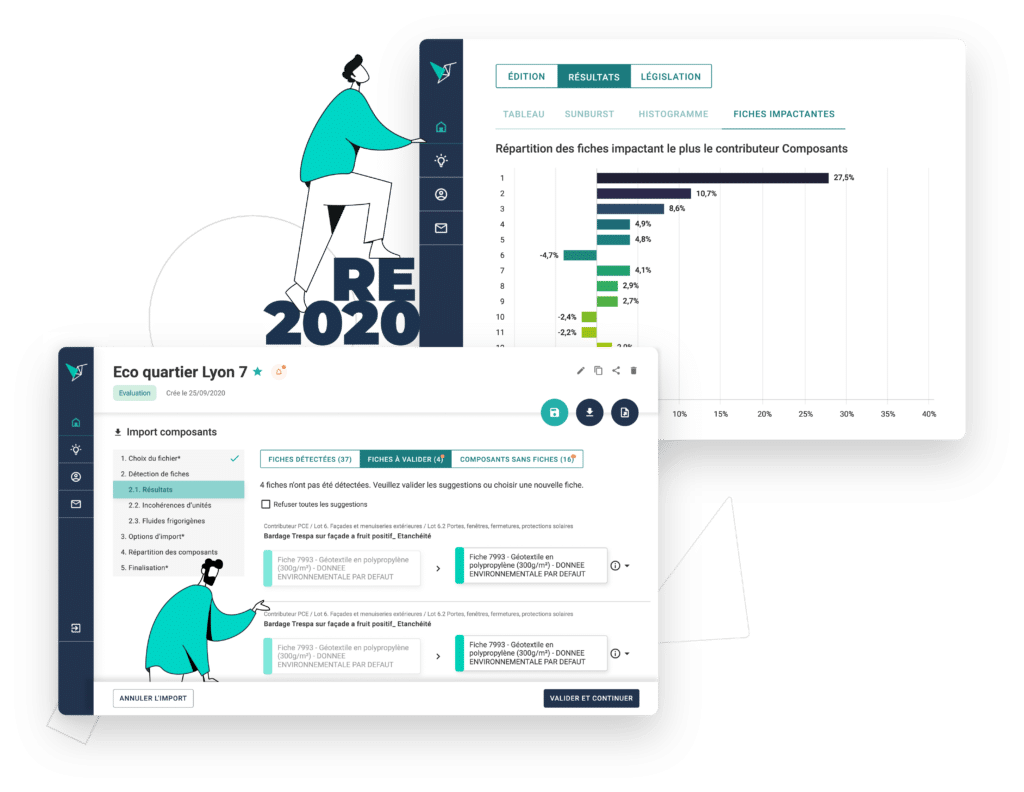LCA or Life Cycle Assessment of a building
Definition and description of the Life Cycle Assessment of a building, its methodology and regulatory framework.

What is it and what's it for?
Life Cycle Assessment is a method for evaluating the environmental impact of a building over its entire life cycle: from design to end-of-life management.
This is a scientific method that compares alternatives using a quantitative approach.
- Standardized (which consists of evaluating the environmental impacts of a system on a given perimeter (NF EN ISO 14040))
- Multicriteria
- Quantitative
Ultimately, the aim of building LCA is to quantify energy, material and water flows, whether incoming or outgoing, for each stage in the building's life cycle, and to translate their impact on the environment through different impact categories (such as climate change, resource depletion or soil acidification).
How does LCA apply to different areas of the building sector?
LCA in the construction sector applies to two areas: one concerns the manufacture of components and the other the assessment of the complete building design scenario.
This involves taking into account the quantities of materials used, the architectural design choices made, etc.Feb 17, 2021.
What stages are taken into account in the LCA of a building?
Building LCA takes into account all the stages involved in a construction project. It begins with the extraction of the raw materials needed to produce the building products, and ends with the building's end-of-life.
Between these two stages, it includes all the intermediate phases: waste treatment, operation, impacts linked to the transport of components, etc.
In detail, this life cycle analysis can be broken down into 5 main stages:
- Production (A1-A3) : Acquisition of raw materials, transport to processing plant and manufacture of finished product
- Construction (A4-A5): Product transport to the construction site, construction and installation processes for materials and finished products on the construction site
- Use (B1-B7): The entire life of the building, including: use, maintenance, repair, replacement of materials and finished products, energy and water consumption during use of the building.
- End-of-life (C1-C4) : Deconstruction of the structure, transport to the recovery or disposal site, treatment and disposal of materials and finished products.
- Benefits and costs beyond the life cycle (D): what happens to the product after its end-of-life? What positive externalities can be derived from its re-use?
What are the steps involved in carrying out an LCA?
The LCA methodological framework is based on the ISO 14044 standard. To carry out an LCA, you need :
- First, define the scope and objectives of the study,
- Carry out and analyze the inventory (Life Cycle Inventory / LCI),
- Calculate and assess the impact of this inventory,
- And finally, to interpret all the results obtained.
What is the European standard for building LCA?
Since 2012, standard NF EN 15978 "Contribution of construction works to sustainable development - Evaluation of the environmental performance of buildings - Calculation method" has provided the European calculation method based on LCA and other quantified environmental information.
What is the French standard for building LCA?
The Réglementation Environnementale 2020 (RE 2020), which came into force on January 1, 2022, now applies to all multi-family housing in France.
After phases of experimentation and consultation, notably with the E+C- label since 2016, it succeeds the RT 2012 thermal regulations.
Discover our Vizcab software to certify and label your low-carbon construction projects.
From the diagnostic and feasibility phase to the execution phase of a construction project, we offer software tailored to each professional to build your low-carbon strategy.



Upstream phase
Right from the design stage, secure the cost/carbon objective of your projects.
Optimize the profitability of your project by playing on the parameters that will have the greatest impact on achieving your objectives, and unite your stakeholders with powerful communication tools.

Downstream phase
Calculate and optimize the environmental impact of your projects
Vizcab Eval is the solution to help you produce reliable, robust and effective building LCA studies in the shortest possible time.
